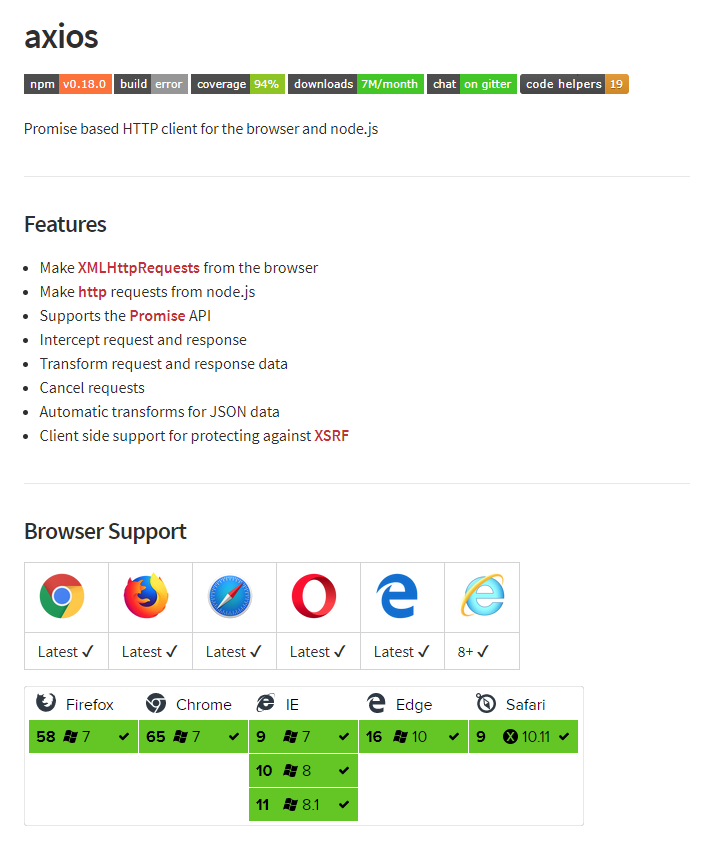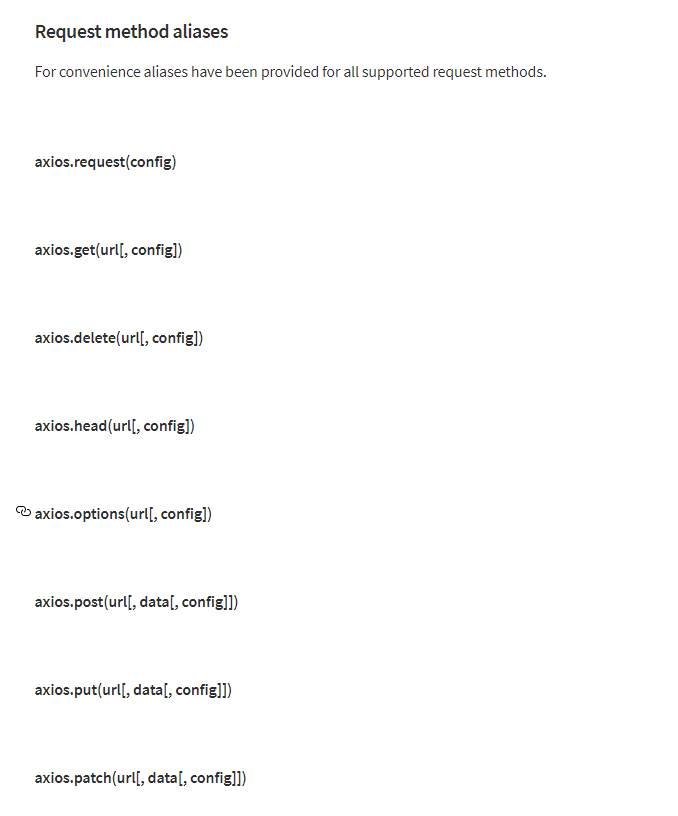在vue的项目中以前是使用vue-resource来请求数据,随着vue2的使用官方推荐使用axios,首先看看npm给出的axios定义以及兼容性:
在使用之前需要安装axios,在项目的根目录下打开命令窗口输入一下代码安装axios:
npm install axiosget方式使用:
axios.get('/user?ID=12345')
.then(function (response) {
console.log(response);
})
.catch(function (error) {
console.log(error);
});post方式使用:
axios.post('/user', {
firstName: 'Fred',
lastName: 'Flintstone'
})
.then(function (response) {
console.log(response);
})
.catch(function (error) {
console.log(error);
});post方式我在使用的过程中遇到了点小问题,就是后台一直拿不到我传递的数据,后来通过一下方法解决:
var params = new URLSearchParams();
params.append('activityId', this.activityId);
axios.post(this.HOST + '/enterReceivePage',params).then(res => {
var obj = JSON.parse(res.data);
this.hbinfo = obj.data;
})就是需要将传递的参数通过urlsearchparams传递后台才能接受,后台使用的是java开发的api。
配置的方式:
axios({
method: 'post',
url: '/user/12345',
data: {
firstName: 'Fred',
lastName: 'Flintstone'
}
});axios({
method:'get',
url:'/user',
})
.then(function(response) {
});还有很多restful api常用的方式如下:
请求的配置选项如下:
{
// 请求地址
url: '/user',
// 请求方法
method: 'get', // default
// 基本路径
baseURL: 'https://base.com/api/',
// `transformRequest` allows changes to the request data before it is sent to the server
// This is only applicable for request methods 'PUT', 'POST', and 'PATCH'
// The last function in the array must return a string or an instance of Buffer, ArrayBuffer,
// FormData or Stream
// You may modify the headers object.
transformRequest: [function (data, headers) {
// Do whatever you want to transform the data
return data;
}],
// `transformResponse` allows changes to the response data to be made before
// it is passed to then/catch
transformResponse: [function (data) {
// Do whatever you want to transform the data
return data;
}],
// 请求头
headers: {'X-Requested-With': 'XMLHttpRequest'},
// 请求参数
// 必须是一个对象或者URLSearchParams对象
params: {
ID: 12345
},
// 参数序列化
paramsSerializer: function(params) {
return Qs.stringify(params, {arrayFormat: 'brackets'})
},
// 需要发送的请求体信息
// 针对'PUT', 'POST', 'PATCH'几个方法
data: {
firstName: 'Fred'
},
// 链接超时时间
timeout: 1000,
// 是否允许跨站设置缓存
withCredentials: false, // default
// `adapter` allows custom handling of requests which makes testing easier.
// Return a promise and supply a valid response (see lib/adapters/README.md).
adapter: function (config) {
/* ... */
},
// `auth` indicates that HTTP Basic auth should be used, and supplies credentials.
// This will set an `Authorization` header, overwriting any existing
// `Authorization` custom headers you have set using `headers`.
auth: {
username: 'janedoe',
password: 's00pers3cret'
},
// 响应的数据类型
responseType: 'json', // default
// `xsrfCookieName` is the name of the cookie to use as a value for xsrf token
xsrfCookieName: 'XSRF-TOKEN', // default
// `xsrfHeaderName` is the name of the http header that carries the xsrf token value
xsrfHeaderName: 'X-XSRF-TOKEN', // default
// `onUploadProgress` allows handling of progress events for uploads
onUploadProgress: function (progressEvent) {
// Do whatever you want with the native progress event
},
// `onDownloadProgress` allows handling of progress events for downloads
onDownloadProgress: function (progressEvent) {
// Do whatever you want with the native progress event
},
// `maxContentLength` defines the max size of the http response content allowed
maxContentLength: 2000,
// `validateStatus` defines whether to resolve or reject the promise for a given
// HTTP response status code. If `validateStatus` returns `true` (or is set to `null`
// or `undefined`), the promise will be resolved; otherwise, the promise will be
// rejected.
validateStatus: function (status) {
return status >= 200 && status < 300; // default
},
// `maxRedirects` defines the maximum number of redirects to follow in node.js.
// If set to 0, no redirects will be followed.
maxRedirects: 5, // default
// `socketPath` defines a UNIX Socket to be used in node.js.
// e.g. '/var/run/docker.sock' to send requests to the docker daemon.
// Only either `socketPath` or `proxy` can be specified.
// If both are specified, `socketPath` is used.
socketPath: null, // default
// `httpAgent` and `httpsAgent` define a custom agent to be used when performing http
// and https requests, respectively, in node.js. This allows options to be added like
// `keepAlive` that are not enabled by default.
httpAgent: new http.Agent({ keepAlive: true }),
httpsAgent: new https.Agent({ keepAlive: true }),
// 'proxy' defines the hostname and port of the proxy server
// Use `false` to disable proxies, ignoring environment variables.
// `auth` indicates that HTTP Basic auth should be used to connect to the proxy, and
// supplies credentials.
// This will set an `Proxy-Authorization` header, overwriting any existing
// `Proxy-Authorization` custom headers you have set using `headers`.
proxy: {
host: '127.0.0.1',
port: 9000,
auth: {
username: 'mikeymike',
password: 'rapunz3l'
}
},
// `cancelToken` specifies a cancel token that can be used to cancel the request
// (see Cancellation section below for details)
cancelToken: new CancelToken(function (cancel) {
})
}常用的几个已经用中文标示,其他的根据自己的实际情况取舍。
响应的数据格式:
{
// 服务器返回的数据
data: {},
// HTTP status code
status: 200,
// `statusText` is the HTTP status message from the server response
statusText: 'OK',
// 响应头信息
headers: {},
// `config` is the config that was provided to `axios` for the request
config: {},
// `request` is the request that generated this response
// It is the last ClientRequest instance in node.js (in redirects)
// and an XMLHttpRequest instance the browser
request: {}
}有了这些基本知识后现在就来封装axios:
首先需要安装axios和qs两个库:
npm install axios
npm install qs新建api.js文件,整体代码如下:
import axios from 'axios'
import qs from 'qs'
const fetch = (
url,
params = {},
options
) => {
let _options = Object.assign({
method: 'post',
withCredentials: true
}, options)
let [ _params, _data ] = _options.method === 'get' ? [ params, ''] : [ '', params]
return axios({
method: _options.method,
url: url,
params: _params,
data: qs.stringify(_data),
withCredentials: _options.withCredentials
})
.then(res => {
let _res = res.data
return _res
})
.catch(e => {
return e
})
}
export default fetch目前只是一些简单配置,可以根据自己的项目来增减相应的配置选项。
使用如下:
import axios from 'api'
axios(this.HOST+'/Index/searchCus',{token:sessionStorage.token,phone:this.phone},{method:'post'})
.then(res => {
console.log(res)
});好了到此就封装完成了,以后所有的项目就可以使用这个api文件了,记住使用前需要在项目根目录安装axios和qs两个库才能正常使用。
如果觉得有帮助请我吃个糖吧!



